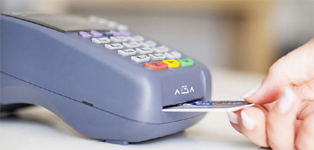What is EMV and Why Should I Care?
If you're a business owner and you accept credit card payments for all or some of your products or services, the future burden of recouping false charges on stolen cards and identities will fall on you and your pocketbook, yes you, read on…
What is it?
It's a new standard and technology commonly called "smart cards" or "chip-and-pin cards" that will shift the liability of credit card fraud and identity theft more toward the merchant and less toward the current credit card issuing banks.
Formally, it's called "EMV" the name comes from the initial letters of Europay, MasterCard and VISA, the three companies that originally cooperated to develop the standard to dramatically reduce fraudulent credit card transactions.

Why have a new standard?
The existing system of using plastic credit cards with a magnetic strip on the back in which the terminal reads the strip is archaic and full of security holes. The data on the magnetic strip can be skimmed and cards can be easily cloned. Other than a signature panel on the back of the card, which hardly any merchant checks, there is nothing that authenticates the card to the customer. Hence the bad guys have a field day.
EMV has been in practice in Europe for years and fraudulent credit card transaction have dropped dramatically as a result. In the UK alone fraud on lost or stolen cards is at its lowest level since 1999.
Conversely, the US leads the world in credit card fraud. The U.S. accounts for approximately 47% of global credit and debit card fraud even though it generates only 27% of the total volume of purchases, according to The Nilson Report,
How Does It Work?
In the very near future, customers' "smart" credit cards will have an embedded chip. And the merchant will have a device that can read the data on the chip.
The chip is encrypted with data. EMV-enabled devices have the ability to read data stored on a chip within the card. During the transaction authorization process, highly advanced sophisticated cryptographic functions are used to validate the authenticity of the card and cardholder. The encryption is unique to each transaction and cannot be hacked.
Furthermore, the cardholder is asked to enter their pin number on a keypad. This is the final step to authenticate the card to the cardholder. Thus the new catchall phrase for this new technology is called "chip-and-pin".
What Changes?
The biggest change will be that business owners will either have to totally replace their current credit card terminals with the latest models that can read smart card and allow the customers to enter their pin numbers.
However, some, not all, credit card terminals currently deployed and have a special external reader that will plug into the current port on the terminal and that will get the business owner compliant with the latest standard.
Key Date:
The target date for a complete cutover in the U.S. is October 1, 2015 that's when liability will shift to merchants for fraudulent swiped transactions if the merchant does not have an EMV-enabled credit card device.
At NCR/JetPay we are installing more and more credit card terminals that are "future-proofed" in this regard, when the final passage of the new EMV standard is enacted, we have a plug in pin pad that has a slot to read the chip card and whereby the customer can key in their pin number.
About the Author
Al Valente is a business consultant servicing New England and helps customers to make smart investment decisions in selecting their payments processing systems. He is an independent agent for NCR/JetPay and Upserve.
|
|

